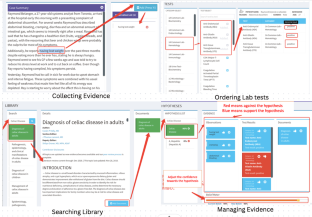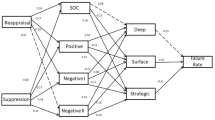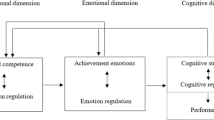Abstract
Academic emotions play an important and complex role in self-regulated learning (SRL). However, few studies have examined how academic emotions unfold in different phases of SRL and how the changes in these emotions influence learning performance. The current study examines 98 students’ academic emotion trajectories and profiles across the three phases of SRL (i.e., forethought, performance, and self-reflection) as they solve a clinical problem in BioWorld. Specifically, BioWorld is a simulated learning environment where medical students are tasked with diagnosing virtual patient diseases. We identified the three phases of SRL based on students’ problem-solving behaviors and we asked students to self-report their achievement and epistemic emotions at the end of each phase of SRL. The growth curve model results showed that curiosity and confusion declined across the three phases of SRL, whereas boredom increased in the self-reflection phase of SRL. The initial levels of curiosity and enjoyment positively predicted students’ performance. Latent transition analysis revealed three emotion profiles: curious-positive, confused-negative, and medium–low. Curious-positive students maintained a relatively stable profile through the SRL phases, whereas students in the confused-negative and medium–low groups exhibited specific transition patterns in their emotions. This study makes theoretical contributions by highlighting the temporal and dynamic nature of emotions in problem-solving. Findings from this study have educational implications regarding the role of specific emotions in learning, the development of one’s awareness of their emotions, and emotion regulation.







Similar content being viewed by others
Data Availability
The data that support the findings of this study are available on request from the corresponding author. The data are not publicly available due to privacy or ethical restrictions.
References
Ainley, M., Corrigan, M., Richardson, N. (2005). Students tasks and emotions: Identifying the contribution of emotions to students' reading of popular culture and popular science texts. Learning and Instruction, 15(5), 433–447.
Agarwal, N. K. (2011). Verifying survey items for construct validity: A two-stage sorting procedure for questionnaire design in information behavior research. Proceedings of the American Society for Information Science and Technology, 48(1), 1–8. https://doi.org/10.1002/meet.2011.14504801166
Ahmed, W., van der Werf, G., Kuyper, H., & Minnaert, A. (2013). Emotions, self-regulated learning, and achievement in mathematics: A growth curve analysis. Journal of Educational Psychology, 105(1), 150–161. https://doi.org/10.1037/a0030160
Alonso-Martin, F., Malfaz, M., Sequeira, J., Gorostiza, J. F., & Salichs, M. A. (2013). A multimodal emotion detection system during human–robot interaction. Sensors, 13(11), 15549–15581.
American Diabetes Association. (2002). Screening for diabetes. Diabetes Care, 25(1), 21–24.
Artino, A. R. J., Hemmer, P. A., & Durning, S. J. (2011). Using self-regulated learning theory to understand the beliefs, emotions, and behaviors of struggling medical students. Academic Medicine, 86(10), 35–38. https://doi.org/10.1097/ACM.0b013e31822a603d
Aspinwall, L. G. (1998). Rethinking the role of positive affect in self-regulation. Motivation and Emotion, 22(1), 1–32. https://doi.org/10.1023/A:1023080224401
Brondino, M., Raccanello, D., & Pasini, M. (2014). Achievement goals as antecedents of achievement emotions: The 3 X 2 achievement goal model as a framework for learning environments design. In T. Mascio, R. Gennari, P. Vitorini, R. Vicari, & F. de la Prieta (Eds.), Methodologies and intelligent systems for technology enhanced learning (pp. 53–60). Springer.
Ciechanowski, P. S., Katon, W. J., Russo, J. E., & Hirsch, I. B. (2003). The relationship of depressive symptoms to symptom reporting, self-care and glucose control in diabetes. General Hospital Psychiatry, 25(4), 246–252. https://doi.org/10.1016/S0163-8343(03)00055-0
Curran, P. J., Obeidat, K., & Losardo, D. (2010). Twelve frequently asked questions about growth curve modeling. Journal of Cognition and Development, 11(2), 121–136. https://doi.org/10.1080/15248371003699969
Daniels, L. M., Stupnisky, R. H., Pekrun, R., Haynes, T. L., Perry, R. P., & Newall, N. E. (2009). A longitudinal analysis of achievement goals: From affective antecedents to emotional effects and achievement outcomes. Journal of Educational Psychology, 101(4), 948–963. https://doi.org/10.1037/a0016096
D’Mello, S. (2012). Monitoring affective trajectories during complex learning. In N. M. Seel (Ed.), Encyclopedia of the Sciences of Learning (pp. 2325–2328). Springer. https://doi.org/10.1007/978-1-4419-1428-6_849
D’Mello, S. (2013). A selective meta-analysis on the relative incidence of discrete affective states during learning with technology. Journal of Educational Psychology, 105(4), 1082.
D’Mello, S., & Graesser, A. (2012). Dynamics of affective states during complex learning. Learning and Instruction, 22(2), 145–157. https://doi.org/10.1016/j.learninstruc.2011.10.001
D’Mello, S., Lehman, B., Pekrun, R., & Graesser, A. (2014). Confusion can be beneficial for learning. Learning and Instruction, 29, 153–170. https://doi.org/10.1016/j.learninstruc.2012.05.003
Duffy, M. C., Lajoie, S. P., Pekrun, R., & Lachapelle, K. (2018). Emotions in medical education: Examining the validity of the Medical Emotion Scale (MES) across authentic medical learning environments. Learning and Instruction, 70, 101150. https://doi.org/10.1016/j.learninstruc.2018.07.001
Efklides, A. (2011). Interactions of metacognition with motivation and affect in self-regulated learning: The MASRL Model. Educational Psychologist, 46(1), 6–25. https://doi.org/10.1080/00461520.2011.538645
Efklides, A. (2017). Affect, epistemic emotions, metacognition, and self-Regulated learning. Teachers College Record, 119(13), 1–13.
Fernando, J. W., Kashima, Y., & Laham, S. M. (2014). Multiple emotions: A person-centered approach to the relationship between intergroup emotion and action orientation. Emotion, 14(4), 722–732. https://doi.org/10.1037/a0036103
Foster, M. I., & Keane, M. T. (2015). Why some surprises are more surprising than others: Surprise as a metacognitive sense of explanatory difficulty. Cognitive Psychology, 81, 74–116.
Frenzel, A. C., Pekrun, R., & Goetz, T. (2007). Girls and mathematics—A “hopeless” issue? A control-value approach to gender differences in emotions towards mathematics. European Journal of Psychology of Education, 22(4), 497.
Ganotice, F. A., Datu, J. A. D., & King, R. B. (2016). Which emotional profiles exhibit the best learning outcomes? A person-centered analysis of students’ academic emotions. School Psychology International, 37(5), 498–518. https://doi.org/10.1177/0143034316660147
Goetz, T., Becker, E. S., Bieg, M., Keller, M. M., Frenzel, A. C., & Hall, N. C. (2015). The glass half empty: How emotional exhaustion affects the state-trait discrepancy in self-reports of teaching emotions. PLoS ONE, 10(9), 1–14. https://doi.org/10.1371/journal.pone.0137441
Greene, J. A., & Schunk, D. H. (2018). Historical, contemporary, and future perspectives on self-regulated learning and performance. In D. Schunk & J.A. Greene (Eds.), Handbook of self-regulation of learning and performance (pp. 18–32). Routledge.
Hesser, H. (2015). Modeling individual differences in randomized experiments using growth models: Recommendations for design, statistical analysis and reporting of results of internet interventions. Internet Interventions, 2(2), 110–120.
Hoogland, J. J., & Boomsma, A. (1998). Robustness studies in covariance structure modeling: An overview and a meta-analysis. Sociological Methods & Research, 26(3), 329–367.
Isen, A. M. (2004). Some perspectives on positive feelings and emotions: Positive affect facilitates thinking and problem-solving. In A. S. R. Manstead, N. Frijda, & A. Fischer (Eds.), Feelings and emotions: The Amsterdam symposium (pp. 263–281). Cambridge University Press.
Isen, A. M., Rosenzweig, A. S., & Young, M. J. (1991). The influence of positive affect on cinical problem solving. Medical Decision Making, 11(3), 221–227. https://doi.org/10.1177/0272989X9101100313
Jarrell, A. (2018). The regulation of achievement emotions in higher education: An examination of emotion (Publication No. 10169573). [Doctoral dissertation, McGill University]. ProQuest Dissertations & Theses Global.
Jarrell, A., Harley, J. M., & Lajoie, S. P. (2016). The link between achievement emotions, appraisals, and task performance: Pedagogical considerations for emotions in CBLEs. Journal of Computers in Education, 3(3), 289–307. https://doi.org/10.1007/s40692-016-0064-3
Jarrell, A., Harley, J. M., Lajoie, S., & Naismith, L. (2017). Success, failure and emotions: Examining the relationship between performance feedback and emotions in diagnostic reasoning. Educational Technology Research and Development, 65(5), 1263–1284. https://doi.org/10.1007/s11423-017-9521-6
Keeley, J., Zayac, R., & Correia, C. (2008). Curvilinear relationships between statistics anxiety and performance among undergraduate students: Evidence for optimal anxiety. Statistics Education Research Journal, 7(1), 4–15. Scopus.
Kim, S., Georgiou, P. G., Lee, S., & Narayanan, S. (2007). Real-time emotion detection system using speech: Multi-modal fusion of different timescale features. In 2007 IEEE 9th Workshop on Multimedia Signal Processing (pp. 48–51). IEEE.
Kline, R. B. (2015). Principles and practice of structural equation modeling (4th ed.). Guilford publications.
Kuiper, R. A. (2013). Integration of innovative clinical reasoning pedagogies into a baccalaureate nursing curriculum. Creative Nursing, 19(3), 128–139.
Laffel, L. (1999). Ketone bodies: A review of physiology, pathophysiology and application of monitoring to diabetes. Diabetes/metabolism Research and Reviews, 15(6), 412–426.
Lajoie, S. P. (2009). Developing professional expertise with a cognitive apprenticeship model: Examples from avionics and medicine. In K. A. Ericsson (Ed.), Development of professional expertise: Toward measurement of expert performance and design of optimal learning environments (pp. 61–83). Cambridge University Press.
Lajoie, S. P., Zheng, J., & Li, S. (2018). Examining the role of self-regulation and emotion in clinical reasoning: Implications for developing expertise. Medical Teacher, 40(8), 842–844. https://doi.org/10.1080/0142159X.2018.1484084
Lajoie, S. P., Zheng, J., Li, S., Jarrell, A., & Gube, M. (2019). Examining the interplay of affect and self regulation in the context of clinical reasoning. Learning and Instruction, 72, 101219. https://doi.org/10.1016/j.learninstruc.2019.101219
Little, R. J. (1988). A test of missing completely at random for multivariate data with missing values. Journal of the American Statistical Association, 83(404), 1198–1202.
Li, S., Zheng, J., & Lajoie, S. P. (2021a). The frequency of emotions and emotion variability in self-regulated learning: What matters to task performance?. Frontline Learning Research, 9(4), 76–91.
Li, S., Zheng, J., Lajoie, S. P., & Wiseman, J. (2021b). Examining the relationship between emotion variability, self-regulated learning, and task performance in an intelligent tutoring system. Educational Technology Research and Development, 69(2), 673–692.
Loderer, K., Pekrun, R., & Lester, J. C. (2020). Beyond cold technology: A systematic review and meta-analysis on emotions in technology-based learning environments. Learning and Instruction, 70, 101162.
Martinent, G., Gareau, A., Lienhart, N., Nicaise, V., & Guillet-Descas, E. (2018). Emotion profiles and their motivational antecedents among adolescent athletes in intensive training settings. Psychology of Sport and Exercise, 35, 198–206. https://doi.org/10.1016/j.psychsport.2018.01.001
McConnell, M. M., Monteiro, S., Pottruff, M. M., Neville, A., Norman, G. R., Eva, K. W., & Kulasegaram, K. (2016). The impact of emotion on learners’ application of basic science principles to novel problems. Academic Medicine, 91(11), 58–63. https://doi.org/10.1097/ACM.0000000000001360
Mega, C., Ronconi, L., & De Beni, R. (2014). What makes a good student? How emotions, self-regulated learning, and motivation contribute to academic achievement. Journal of Educational Psychology, 106(1), 121–131.
Menart-Houtermans, B., Rütter, R., Nowotny, B., Rosenbauer, J., Koliaki, C., Kahl, S., Simon, M.-C., Szendroedi, J., Schloot, N. C., & Roden, M. (2014). Leukocyte profiles differ between Type 1 and Type 2 diabetes and are associated with metabolic phenotypes: Results from the German Diabetes study (GDS). Diabetes Care, 37(8), 2326–2333. https://doi.org/10.2337/dc14-0316
Muis, K. R., Ranellucci, J., Trevors, G., & Duffy, M. C. (2015a). The effects of technology-mediated immediate feedback on kindergarten students’ attitudes, emotions, engagement and learning outcomes during literacy skills development. Learning and Instruction, 38, 1–13. https://doi.org/10.1016/j.learninstruc.2015.02.001
Muis, K. R., Chevrier, M., & Singh, C. A. (2018). The role of epistemic emotions in personal epistemology and self-regulated learning. Educational Psychologist, 53(3), 165–184. https://doi.org/10.1080/00461520.2017.1421465
Muis, K. R., Pekrun, R., Sinatra, G. M., Azevedo, R., Trevors, G., Meier, E., & Heddy, B. C. (2015b). The curious case of climate change: Testing a theoretical model of epistemic beliefs, epistemic emotions, and complex learning. Learning and Instruction, 39, 168–183. https://doi.org/10.1016/j.learninstruc.2015.06.003
Munzar, B., Muis, K. R., Denton, C. A., & Losenno, K. (2020). Elementary students’ cognitive and affective responses to impasses during mathematics problem solving. Journal of Educational Psychology, 113(1), 104–124. https://doi.org/10.1037/edu0000460
Muthén, L. K., & Muthén, B. O. (2012). MPlus: Statistical analysis with latent variables—User’s guide.
Naismith, L. M., & Lajoie, S. P. (2018). Motivation and emotion predict medical students’ attention to computer-based feedback. Advances in Health Sciences Education, 23(3), 465–485. https://doi.org/10.1007/s10459-017-9806-x
Nerantzaki, K., & Efklides, A. (2019). Epistemic emotions: Interrelationships and changes during task processing. Hellenic Journal of Psychology, 16(2), 177–199.
Niculescu, A. C., Tempelaar, D. T., Dailey-Hebert, A., Segers, M., & Gijselaers, W. H. (2016). Extending the change–change model of achievement emotions: The inclusion of negative learning emotions. Learning and Individual Differences, 47, 289–297. https://doi.org/10.1016/j.lindif.2015.12.015
Nylund, K. L., Asparouhov, T., & Muthén, B. O. (2007). Deciding on the number of classes in latent class analysis and growth mixture modeling: A Monte Carlo simulation study. Structural Equation Modeling: A Multidisciplinary Journal, 14(4), 535–569.
Panadero, E. (2017). A review of self-regulated learning: Six models and four directions for research. Frontiers in Psychology, 8(422), 1–28. https://doi.org/10.3389/fpsyg.2017.00422
Pekrun, R. (2006). The control-value theory of achievement emotions: Assumptions, corollaries, and implications for educational research and practice. Educational Psychology Review, 18(4), 315–341. https://doi.org/10.1007/s10648-006-9029-9
Pekrun, R., Goetz, T., Titz, W., & Perry, R. P. (2002). Academic emotions in students’ self-regulated learning and achievement: A program of qualitative and quantitative Research. Educational Psychologist, 37(2), 91–105. https://doi.org/10.1207/S15326985EP3702_4
Pekrun, R., & Perry, R. P. (2014). Control-value theory of achievement emotions. In R. Pekrun & L. Linnerbrink-Garcia (Eds.), International handbook of emotions in education (pp. 120–141). Taylor & Francis. https://doi.org/10.4324/9780203148211.ch7
Pekrun, R., & Stephens, E. J. (2012). Academic emotions. In K. Harris, S. Graham, T. Urdan, S. Graham, J. Royer, & M. Zeidner (Eds.), Individual differences and cultural and contextual factors. APA educational psychology handbook, Vol. 2 (pp. 3–31). American Psychological Association. https://doi.org/10.1037/13274-001
Pekrun, R., Vogl, E., Muis, K. R., & Sinatra, G. M. (2017). Measuring emotions during epistemic activities: The Epistemically-Related Emotion Scales. Cognition and Emotion, 31(6), 1268–1276. https://doi.org/10.1080/02699931.2016.1204989
Peterson, E. R., Brown, G. T. L., & Jun, M. C. (2015). Achievement emotions in higher education: A diary study exploring emotions across an assessment event. Contemporary Educational Psychology, 42, 82–96. https://doi.org/10.1016/j.cedpsych.2015.05.002
Plutchik, R. (2001). The nature of emotions: Human emotions have deep evolutionary roots, a fact that may explain their complexity and provide tools for clinical practice. American scientist, 89(4), 344–350.
Putwain, D. W., Becker, S., Symes, W., & Pekrun, R. (2018). Reciprocal relations between students’ academic enjoyment, boredom, and achievement over time. Learning and Instruction, 54, 73–81. https://doi.org/10.1016/j.learninstruc.2017.08.004
Robinson, K. A., Ranellucci, J., Lee, Y., Wormington, S. V., Roseth, C. J., & Linnenbrink-Garcia, L. (2017). Affective profiles and academic success in a college science course. Contemporary Educational Psychology, 51, 209–221. https://doi.org/10.1016/j.cedpsych.2017.08.004
Robinson, M. D., & Clore, G. L. (2002). Belief and feeling: Evidence for an accessibility model of emotional self-report. Psychological Bulletin, 128(6), 934–960. https://doi.org/10.1037//0033-2909.128.6.934
Raccanello, D., Brondino, M., Crane, M., & Pasini, M. (2016). Antecedents of achievement emotions: Mixed-device assessment with Italian and Australian university students. In M. Caporuscio, F. De la Prieta, T. Di Mascio, R. Gennari, J. Gutierrez Rodriguez, & P. Vittorini (Eds.), Methodologies and intelligent systems for technology enhanced learning (pp. 183–191). Springer.
Scherer, K. R. (2009). The dynamic architecture of emotion: Evidence for the component process model. Cognition and Emotion, 23(7), 1307–1351.
Schmitz, B., Klug, J., & Schmidt, M. (2011). Assessing self-regulated learning using diary measures with university students. In B. Zimmerman & D. Schunk (Eds.), Handbook of self-regulation of learning and performance (pp. 251–266). Routledge New York.
Silvia, P. J. (2010). Confusion and interest: The role of knowledge emotions in aesthetic experience. Psychology of Aesthetics, Creativity, and the Arts, 4(2), 75–80. https://doi.org/10.1037/a0017081
Sinclair, J., Jang, E. E., Azevedo, R., Lau, C., Taub, M., & Mudrick, N. V. (2018). Changes in emotion and their relationship with learning gains in the context of MetaTutor. In R. Nkambou, R. Azevedo, & J. Vassileva (Eds.), Intelligent tutoring systems (pp. 202–211). Springer International Publishing. https://doi.org/10.1007/978-3-319-91464-0_20
Singer, J. D., & Willett, J. B. (2003). Applied longitudinal data analysis: Modeling change and event occurrence. Oxford University Press.
Taub, M., Sawyer, R., Lester, J., & Azevedo, R. (2020). The impact of contextualized emotions on self-regulated learning and scientific reasoning during learning with a game-based learning environment. International Journal of Artificial Intelligence in Education, 30(1), 97–120. https://doi.org/10.1007/s40593-019-00191-1
Timmermans, T., Mechelen, I. V., & Kuppens, P. (2010). The relationship between individual differ- ences in intraindividual variability in core affect and interpersonal behaviour. European Journal of Personality, 24(8), 623–638. https://doi.org/10.1002/per.756
Turner, J. R., & Gellman, M. (2013). Encyclopedia of Behavioral Medicine. Springer Science+Business Media. https://doi.org/10.1007/978-1-4419-1005-9
Vogl, E., Pekrun, R., Murayama, K., Loderer, K., & Schubert, S. (2019). Surprise, curiosity, and confusion promote knowledge exploration: Evidence for robust effects of epistemic emotions. Frontiers in Psychology, 10, 1–16. https://doi.org/10.3389/fpsyg.2019.02474
Vogl, E., Pekrun, R., Murayama, K., & Loderer, K. (2020). Surprised–curious–confused: Epistemic emotions and knowledge exploration. Emotion, 20(4), 625–641. https://doi.org/10.1037/emo0000578
Wang, J., & Wang, X. (2020). Structural equation modeling: Applications using Mplus (2nd ed.). John Wiley & Sons Ltd.
Zheng, J., Huang, L., Li, S., Lajoie, S. P., Chen, Y., & Hmelo-Silver, C. E. (2021). Self-regulation and emotion matter: A case study of instructor interactions with a learning analytics dashboard. Computers & Education, 161, 104061.
Zimmerman, B. J. (1990). Self-regulated learning and academic achievement: An overview. Educational Psychologist, 25(1), 3–17. https://doi.org/10.1207/s15326985ep2501_2
Zimmerman, B. J. (2000). Attaining self-regulation: A social cognitive perspective. In M. Boekaerts, P. R. Pintrich, & M. Zeidner (Eds.), Handbook of self-Regulation (pp. 13–39). Academic Press. https://doi.org/10.1016/B978-012109890-2/50031-7
Zimmerman, B. J. (2002). Becoming a self-regulated learner: An overview. Theory into Practice, 41(2), 64–70. https://doi.org/10.1207/s15430421tip4102_2
Funding
The research was supported by the Fonds de Recherche du Québec-Société et Culture (FRQSC) awarded to the first author, as well as in part by the Social Sciences and Humanities Research Council of Canada (SSHRC) awarded to the second author.
Author information
Authors and Affiliations
Contributions
Juan Zheng: Conceptualization, Methodology, Investigation, Data Curation, Formal analysis, Writing – Original Draft.
Susanne P. Lajoie: Writing- Reviewing and Editing, Software, Supervision, Funding acquisition.
Shan Li: Investigation, Resources, Formal analysis, Writing- Reviewing and Editing.
Hongbin Wu: Investigation, Resources, Writing- Reviewing and Editing.
Corresponding author
Ethics declarations
The research was conducted in accordance with the journal’s ethical guidelines. The authors declare that the work described was original research that has not been published previously, and not under considerations for publication elsewhere.
Conflict of interests
The authors declare that they have no conflict of interest.
Additional information
Publisher's note
Springer Nature remains neutral with regard to jurisdictional claims in published maps and institutional affiliations.
Rights and permissions
Springer Nature or its licensor (e.g. a society or other partner) holds exclusive rights to this article under a publishing agreement with the author(s) or other rightsholder(s); author self-archiving of the accepted manuscript version of this article is solely governed by the terms of such publishing agreement and applicable law.
About this article
Cite this article
Zheng, J., Lajoie, S.P., Li, S. et al. Temporal change of emotions: Identifying academic emotion trajectories and profiles in problem-solving. Metacognition Learning 18, 315–345 (2023). https://doi.org/10.1007/s11409-022-09330-x
Received:
Accepted:
Published:
Issue Date:
DOI: https://doi.org/10.1007/s11409-022-09330-x




